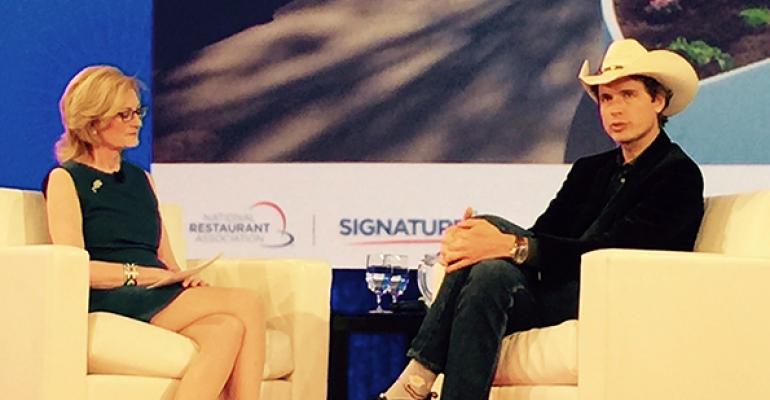Turning the tables on conventional solutions was the theme of the keynote presentation at the National Restaurant Association Show on Sunday, an event that turned the spotlight on three innovators approaching the industry in very different ways.
The Kitchen focuses on community
First up in a series of interviews by NRA president and CEO Dawn Sweeney was Kimball Musk, co-founder of the Boulder, Colo.-born farm-to-table concepts The Kitchen and the more-casual sister brand Next Door, who believes “food is the new internet” as a community builder.
The seven restaurants in Colorado, Chicago and, soon Memphis, Tenn., have grown with close ties to local farms.
The restaurants also help fund a nonprofit called The Kitchen Community, which builds learning gardens in schools designed to teach children about where food comes from. The program will include 300 learning gardens by mid-July reaching more than 160,000 kids every school day.
Kimball, who serves on the board for Chipotle Mexican Grill Inc. and whose brother is Elon Musk, CEO of both Tesla Motors and Space X, sees a future for restaurants in serving truly local food and developing mutually beneficial partnerships with farmers.
As a $2 million buyer from local farms in Colorado, The Kitchen has been able to train farmers to better meet the restaurants’ needs. “We come in as a trusted buyer. We explain that you have to show up at 7 a.m. If you want to work with restaurants, that’s how you do it,” he said.
[CHARTBEAT:3]
The company’s same-store sales grew 25 percent in 2015, he said, indicating that the focus on local growers is having an impact. “People really got the value of local,” he said. “I’m really excited about the future of local food.”
Red Robin Gourmet Burgers reinvents itself
 Denny Marie Post, president of Red Robin Gourmet Burgers and Brews, described how her casual-dining brand has worked to reinvent itself over the past five years.
Denny Marie Post, president of Red Robin Gourmet Burgers and Brews, described how her casual-dining brand has worked to reinvent itself over the past five years.
Born as a Seattle tavern with lively bar sales and great burgers, Red Robin morphed into a family oriented, kid-centric brand, only to find those guests abandoning them when the recession hit.
So the Greenwood Village, Colo.-based chain returned to its roots to refocus on great burgers, shakes and brews with a redesign to accommodate both families and adults on a “date night.”
And, though Red Robin has dived deep into customer research to reshape the brand, she predicted much will change over the next five years as consumer needs evolve.
Guests still want a quick restaurant meal, but they want to have more control over their experience, she said, citing as an example the pizza chains that have taught her son to track their meal’s arrival from oven to doorstep.
“We’ve really got to figure out this new piece of putting the guest in control,” she said.
Post noted that the only segment of casual dining that’s growing now is take out and delivery.
“There will always be a place for coming out for a great dining experience,” said Post, “but the winners are those that will figure out how to package that whole thing up and bring it home.”
UberEats helps restaurants get delivery ready
Jason Droege, head of Uber Everything, is someone who is helping to make that happen.
 The ride-sharing service Uber is only six years old, but is operating in 400 cities round the world with more than 1 million active drivers doing 5 million trips per day.
The ride-sharing service Uber is only six years old, but is operating in 400 cities round the world with more than 1 million active drivers doing 5 million trips per day.
Now, in 14 cities and growing rapidly, Uber has launched UberEats, which works with restaurants to deliver meals, giving diners access to food from restaurants they may never visit but learn to crave.
UberEats works with restaurants to design a limited menu they want to offer for delivery, perhaps avoiding dishes that don’t travel well or can’t be prepared quickly. Restaurants can also determine what distance they’d like to allow their food to travel.
Droege described it as a service that works to meet the specific needs of restaurant operators.
In Toronto, for example, UberEats helped the restaurant Khao San Road stay in business during a temporary closure as it moved to a new location. The restaurant found temporary commissary space and kept offering delivery through UberEats during the transition, allowing employees to stay on the job.
It’s a service Uber is passionate about. “And it’s no secret Uber invests heavily in businesses it’s passionate about,” said Droege.
Droege said he loved working around the “magic” of the restaurant industry, “taking raw ingredients and forming them into something people consume that can change their mood or the life of a city,” he said.
For many workers today, the restaurant industry is also vital to the future health of the American economy, argued Joe Kadow, NRA chairman and executive vice president and chief legal officer for Bloomin’ Brands Inc.
In 2014, the number of households with incomes under $25,000 grew at the highest rate, while there was no growth in the number of households earning between $75,000 and $99,999.
Globalization and technology have put jobs out of reach for many people, he said. Kadow said that while presidential candidates like Donald Trump would love to blame Mexico and China, and the Democratic candidates would blame “greedy corporations,” the reality is that “the traditional pathways are disappearing for those who don’t have the right skills and education.”
The restaurant industry, meanwhile, remains an opportunity open to all, he said.
“The restaurant industry is one of the few paths left to the middle class,” he said.
Contact Lisa Jennings at [email protected]
Follow her on Twitter: @livetodineout





